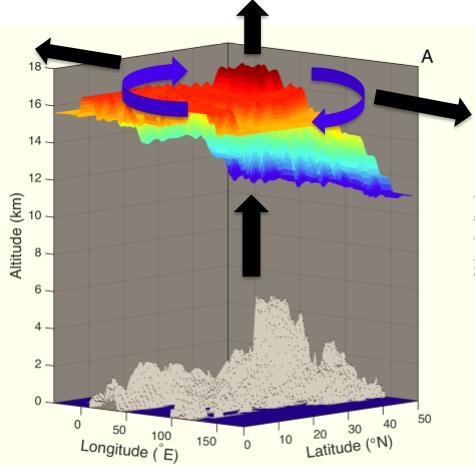Aerosol is currently a hot topic both in scientific community. Scientists know it as a particulate matter, cloud condensation nuclei (CCN) or ice nuclei (IN) while aerosol is known to general public as PM2.5/10 as environmental pollution has become an increasing concern. Stratospheric aerosol, however, very far away from the Earth surface, receives too much less attention, partly because its formation is closely related to the natural sources (such as volcanic plume and oceanic dimethyl sulfide).
Aerosols will have a much longer lifetime (10 - 50 times longer) after their arrival to upper levels, so the ATAL and its diffusion to the entire NH will significantly affect the Earth's energy budget. ATAL will also have impact on stratospheric ozone though heterogeneous chemistry, as aerosols have taken an important role in the depletion of the ozone layer 20~30 years ago. Owing to these important issues, ATAL has received much attention in the scientific community.
In recent years, an Asian tropopause aerosol layer (ATAL) was discovered by both satellite and balloon sounding measurements. The formation of ATAL is considered to be caused by the Asian summer monsoon (ASM), which effectively pumps the Asian pollutants to the upper troposphere and lower stratosphere, leading to enhanced aerosol formation.

The ASM effectively pumps the pollutants to upper levels, leading to the ATAL formation, and that these particles subsequently spread throughout the entire NH lower stratosphere. This plot is provided by the first author of the paper Dr. Pengfei YU from University of Colorado.
In a paper published by PNAS on June 19, 2017, Chinese and American scientists used in situ measurements combined with modeling work to show that these particles subsequently spread throughout the entire Northern Hemispheric (NH) lower stratosphere, and contribute significantly (~15%) to the NH stratospheric column aerosol surface area on an annual basis.
"This contribution is comparable to that from the sum of small volcanic eruptions in the period between 2000 and 2015. " According to the study, "With a substantial amount of organic and sulfur emissions in Asia, the ASM anticyclone serves as an efficient smokestack venting aerosols to the upper troposphere and lower stratosphere."
Dr. BIAN Jianchun, the corresponding author of the study, says, "As economic growth continues in Asia, contribution of Asian emissions to stratospheric aerosol is likely to increase."
BIAN is a scientist from the Institute of Atmospheric Physics, Chinese Academy of Sciences. He is the co-lead of ATMOSPHERIC COMPOSITION AND THE ASIAN MONSOON (ACAM) Working Group 3: Field Campaigns Concept Development. ACAM is a SPARC/IGAC jointly sponsored activity.
Contact: BIAN Jianchun, bjc@mail.iap.ac.cn
